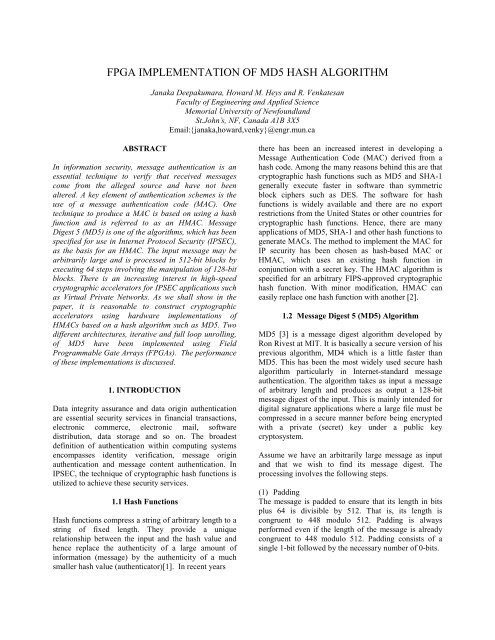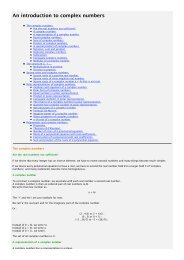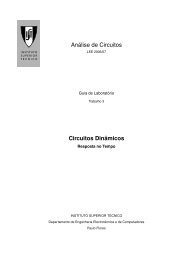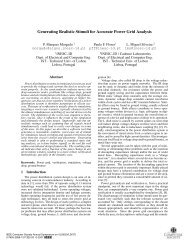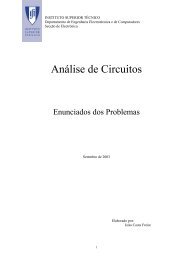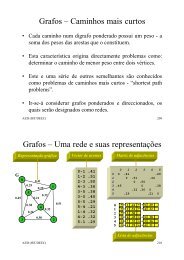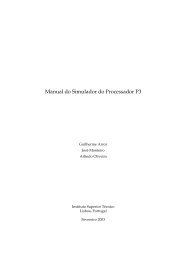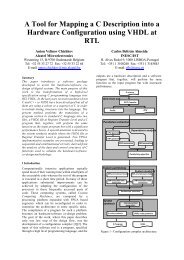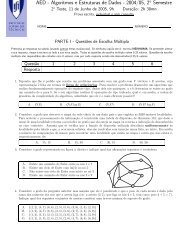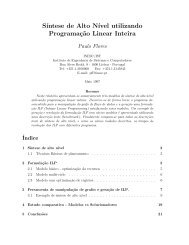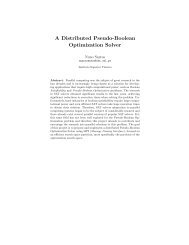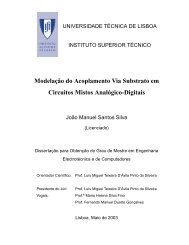FPGA IMPLEMENTATION OF MD5 HASH ALGORITHM
FPGA IMPLEMENTATION OF MD5 HASH ALGORITHM
FPGA IMPLEMENTATION OF MD5 HASH ALGORITHM
You also want an ePaper? Increase the reach of your titles
YUMPU automatically turns print PDFs into web optimized ePapers that Google loves.
<strong>FPGA</strong> <strong>IMPLEMENTATION</strong> <strong>OF</strong> <strong>MD5</strong> <strong>HASH</strong> <strong>ALGORITHM</strong><br />
Janaka Deepakumara, Howard M. Heys and R. Venkatesan<br />
Faculty of Engineering and Applied Science<br />
Memorial University of Newfoundland<br />
St.John’s, NF, Canada A1B 3X5<br />
Email:{janaka,howard,venky}@engr.mun.ca<br />
ABSTRACT<br />
In information security, message authentication is an<br />
essential technique to verify that received messages<br />
come from the alleged source and have not been<br />
altered. A key element of authentication schemes is the<br />
use of a message authentication code (MAC). One<br />
technique to produce a MAC is based on using a hash<br />
function and is referred to as an HMAC. Message<br />
Digest 5 (<strong>MD5</strong>) is one of the algorithms, which has been<br />
specified for use in Internet Protocol Security (IPSEC),<br />
as the basis for an HMAC. The input message may be<br />
arbitrarily large and is processed in 512-bit blocks by<br />
executing 64 steps involving the manipulation of 128-bit<br />
blocks. There is an increasing interest in high-speed<br />
cryptographic accelerators for IPSEC applications such<br />
as Virtual Private Networks. As we shall show in the<br />
paper, it is reasonable to construct cryptographic<br />
accelerators using hardware implementations of<br />
HMACs based on a hash algorithm such as <strong>MD5</strong>. Two<br />
different architectures, iterative and full loop unrolling,<br />
of <strong>MD5</strong> have been implemented using Field<br />
Programmable Gate Arrays (<strong>FPGA</strong>s). The performance<br />
of these implementations is discussed.<br />
1. INTRODUCTION<br />
Data integrity assurance and data origin authentication<br />
are essential security services in financial transactions,<br />
electronic commerce, electronic mail, software<br />
distribution, data storage and so on. The broadest<br />
definition of authentication within computing systems<br />
encompasses identity verification, message origin<br />
authentication and message content authentication. In<br />
IPSEC, the technique of cryptographic hash functions is<br />
utilized to achieve these security services.<br />
1.1 Hash Functions<br />
Hash functions compress a string of arbitrary length to a<br />
string of fixed length. They provide a unique<br />
relationship between the input and the hash value and<br />
hence replace the authenticity of a large amount of<br />
information (message) by the authenticity of a much<br />
smaller hash value (authenticator)[1]. In recent years<br />
there has been an increased interest in developing a<br />
Message Authentication Code (MAC) derived from a<br />
hash code. Among the many reasons behind this are that<br />
cryptographic hash functions such as <strong>MD5</strong> and SHA-1<br />
generally execute faster in software than symmetric<br />
block ciphers such as DES. The software for hash<br />
functions is widely available and there are no export<br />
restrictions from the United States or other countries for<br />
cryptographic hash functions. Hence, there are many<br />
applications of <strong>MD5</strong>, SHA-1 and other hash functions to<br />
generate MACs. The method to implement the MAC for<br />
IP security has been chosen as hash-based MAC or<br />
HMAC, which uses an existing hash function in<br />
conjunction with a secret key. The HMAC algorithm is<br />
specified for an arbitrary FIPS-approved cryptographic<br />
hash function. With minor modification, HMAC can<br />
easily replace one hash function with another [2].<br />
1.2 Message Digest 5 (<strong>MD5</strong>) Algorithm<br />
<strong>MD5</strong> [3] is a message digest algorithm developed by<br />
Ron Rivest at MIT. It is basically a secure version of his<br />
previous algorithm, MD4 which is a little faster than<br />
<strong>MD5</strong>. This has been the most widely used secure hash<br />
algorithm particularly in Internet-standard message<br />
authentication. The algorithm takes as input a message<br />
of arbitrary length and produces as output a 128-bit<br />
message digest of the input. This is mainly intended for<br />
digital signature applications where a large file must be<br />
compressed in a secure manner before being encrypted<br />
with a private (secret) key under a public key<br />
cryptosystem.<br />
Assume we have an arbitrarily large message as input<br />
and that we wish to find its message digest. The<br />
processing involves the following steps.<br />
(1) Padding<br />
The message is padded to ensure that its length in bits<br />
plus 64 is divisible by 512. That is, its length is<br />
congruent to 448 modulo 512. Padding is always<br />
performed even if the length of the message is already<br />
congruent to 448 modulo 512. Padding consists of a<br />
single 1-bit followed by the necessary number of 0-bits.
(2) Appending length<br />
A 64-bit binary representation of the original length of<br />
the message is concatenated to the result of step (1).<br />
(Least significant byte first). The expanded message at<br />
this level will exactly be a multiple of 512-bits. Let the<br />
expanded message be represented as a sequence of L<br />
512-bit blocks Y 0 , Y 1,.., Y q,.., Y L-1 as shown in Figure 1 [4].<br />
Note that in the figure, IV and CV represent initial value<br />
and chaining variable respectively.<br />
512<br />
L x 512 bits<br />
Padding (1-512 bits)<br />
Message 100…. Length<br />
512<br />
512 512<br />
to the integer part of 2 32 times abs(sin(i)), where i is in<br />
radians. Each round also takes as input the current 512-<br />
bit block (Y q ) and the 128-bit chaining variable (CV q ).<br />
An array X of 32-bit words holds the current 512-bit Y q .<br />
For the first round the words are used in their original<br />
order. The following permutations of the words are<br />
defined for rounds 2 through 4:<br />
ρ 2 (i) = (1+ 5i) mod 16<br />
ρ 3 (i) = (5+ 3i) mod 16<br />
ρ 4 (i) = 7i mod 16<br />
512<br />
CVq<br />
128<br />
A B C D<br />
F, T[1 … 16], X[i] 16 steps<br />
Y 0 Y 1 Y q Y L-1<br />
128<br />
H<strong>MD5</strong><br />
128<br />
H<strong>MD5</strong><br />
128 128<br />
H<strong>MD5</strong><br />
H<strong>MD5</strong><br />
Y q<br />
A B C D<br />
G, T[17 … 32], X[ρ2i] 16 steps<br />
128<br />
H, T[33 … 48], X[ρ3i] 16 steps<br />
IV<br />
CV q<br />
CV L-1<br />
128-bit Digest<br />
I, T[49 … 64], X[ρ4i] 16 steps<br />
Figure 1. Generation of message digest<br />
(3) Initialize the MD buffer<br />
The variables IV and CV are represented by a four–word<br />
buffer (ABCD) used to compute the message digest.<br />
Here each A, B, C, D is a 32-bit register and they are<br />
initialized as IV to the following values in hexadecimal.<br />
Low-order bytes are put first.<br />
Word A: 01 23 45 67<br />
Word B: 89 AB CD EF<br />
Word C: FE DC BA 98<br />
Word D: 76 54 32 10<br />
(4) Process message in 16-word blocks<br />
This is the heart of the algorithm, which includes four<br />
“rounds” of processing. It is represented by H <strong>MD5</strong> in<br />
Figure 1 and its logic is given in Figure 2. The four<br />
rounds have similar structure but each uses different<br />
auxiliary functions F, G, H and I.<br />
F(<br />
X , Y , Z ) = ( X ∧ Y ) ∨ ( X ∧ Y )<br />
G(<br />
X , Y , Z ) = ( X ∧ Z ) ∨ ( Y ∧ Z )<br />
H ( X , Y , Z ) = X ⊕ Y ⊕ Z<br />
I ( X , Y , Z ) = Y ⊕ ( X ∨ Z )<br />
where ∨, ∧, ⊕ and ¯ represent the logical OR, AND,<br />
XOR and NOT operations, respectively. Each round<br />
consists of 16 steps and each step uses a 64-element<br />
table T [1 ... 64] constructed from the sine function. Let<br />
T[i] denote the i-th element of the table, which is equal<br />
+ + + +<br />
CV q+1<br />
Figure 2. Compression function H <strong>MD5</strong><br />
The output of the fourth round is added to the input of<br />
the first round (CV q ) to produce CV q+1 .<br />
(5) Output<br />
After all L 512-bit blocks have been processed, the<br />
output from L th stage is the 128-bit message digest.<br />
Figure 3 shows the operations involved in a single step.<br />
The additions are modulo 2 32 . Four different circular<br />
shift amounts (s) are used each round and are different<br />
from round to round. Each step is of the following form<br />
[4]:<br />
A B C D<br />
X[k]<br />
T[i]<br />
+<br />
+<br />
+<br />
A ← D<br />
B ← B + (( A + Func ( B,<br />
C,<br />
D)<br />
+ X [ K ] + T [ I ])
2.1 Iterative Looping Architecture<br />
.<br />
By implementing a generic step of the <strong>MD5</strong> algorithm,<br />
a looping architecture with 64 iterations would seem to<br />
provide the greatest area optimized solution. The block<br />
diagram of the iterative design is shown in Figure 5.<br />
X_in<br />
(Digest)<br />
32<br />
CLK<br />
X_count<br />
X_in<br />
counter<br />
CLK<br />
32<br />
Load_done<br />
XEN2<br />
WE2<br />
XEN1<br />
WE1<br />
<strong>MD5</strong><br />
Iterative<br />
Core<br />
X_addr<br />
X_sel<br />
Count_en<br />
Count_done<br />
T_addr<br />
X_sel<br />
CV_sel<br />
Func_sel<br />
Shift_amnt<br />
en1<br />
en2<br />
<strong>MD5</strong> ITERATIVE<br />
State Machine<br />
Reset_state<br />
Rmcnt_reset<br />
&<br />
Rmcnt_en<br />
Ram<br />
Select<br />
Counter<br />
CLK<br />
Figure 5. Block diagram of <strong>MD5</strong> iterative<br />
design (Iterate_<strong>MD5</strong>).<br />
CV<br />
X_in<br />
32<br />
IV Rom<br />
CV_sel<br />
IV Mux1 128<br />
32<br />
WE1<br />
X_addr XEN1<br />
WE2<br />
T Rom<br />
2<br />
X RAM1<br />
X_addr<br />
4<br />
X RAM2<br />
XEN2<br />
Load_done<br />
Mux 2<br />
32<br />
Ram_sel<br />
A B C<br />
Func_sel<br />
2<br />
Mux3<br />
32<br />
F<br />
G<br />
H<br />
I<br />
32 32<br />
32<br />
A few additional multiplexers and a barrel shifter have<br />
to be used to perform the selection of the round function<br />
and the variable shifting in each round. The state<br />
machine has 68 states including three states required for<br />
initializing and loading the very first block to the core.<br />
In subsequent block operations the state machine<br />
utilizes 65 states. The main feature of this design is the<br />
loading of message blocks in parallel with computation.<br />
The two RAMs can be utilized to load the next block<br />
while the present block is being used in computation.<br />
This eliminates the loading time. The 512-bit message<br />
block is loaded to the core using a 32-bit bus. The<br />
“Reset_state” signal initiates the state machine and the<br />
counters. Then with the “Start” signal the function gets<br />
started. The initial vectors are loaded in parallel to the<br />
input register and to a buffer. The initial vectors as well<br />
as the chaining variables are kept in this buffer until the<br />
64 th step to get added with the last result to form the<br />
chaining variable for the next block. Initially the first<br />
block is loaded to the XRAM1 using the addresses<br />
given by the X_in counter. After that the state machine<br />
starts to provide addresses for reading of XRAM1.<br />
Using the first 16 addresses provided by the state<br />
machine, the next block is written to XRAM2. After the<br />
64 th step, XRAM2 is read. During the first 16 steps of<br />
processing the second block, the third block is written to<br />
XRAM1. This reading and writing of RAMs alternates<br />
in every 64 clock cycles. Subsequent blocks utilize the<br />
previous chaining variable as their initial values. The<br />
generic step is shown in Figure 6.<br />
D<br />
A_buf B_buf C_buf D_buf<br />
32 32 32<br />
en1<br />
32<br />
6<br />
T_addr<br />
Shift_amnt<br />
2.2 Full Loop Unrolling Architecture<br />
The full loop unrolled architecture has a 64-step<br />
combinational logic core as shown in Figure 7. In this<br />
architecture all the elements of each step are<br />
implemented as combinational logic. The barrel shifter<br />
has been removed by direct wiring of appropriate shifted<br />
bits in each step.<br />
.<br />
32<br />
X_in<br />
(Message)<br />
X_in_Count<br />
CV_sel<br />
Load_done<br />
YY<br />
YY_en<br />
IV<br />
ROM<br />
CV<br />
XX<br />
YY2XX<br />
IV<br />
CV Reg<br />
64 –Steps<br />
Digest Reg<br />
A_out B_out C_out D_out<br />
Figure 7 <strong>MD5</strong> full loop-unrolling core<br />
en2<br />
The use of double buffering (XX and YY) eliminates<br />
the loading time from the critical timing path. The next<br />
block is loaded during the computation of the present<br />
block. IV ROM provides the initialization vector for the<br />
first step. The “load_done” signal makes the<br />
initialization vector and the chaining variables available<br />
for the first block and for the subsequent blocks<br />
respectively. During computation of the digest for a<br />
block, the next block is stored in buffer YY and after the<br />
computation the “YY2XX” signal gets high and hence<br />
XX obtains the new input for the next computation. The<br />
block diagram of the complete design is given in Figure<br />
8. In addition to the core, the other main components are<br />
the state machine which has four states, X_in counter<br />
used for loading the blocks to the core and Wait counter<br />
utilized to count the number of cycles for the<br />
combinational logic delay of the computation.<br />
Similar to the iterative design, the “Reset_State” signal<br />
initiates the state machine and the X_in counter. The<br />
initialization vectors are taken into the register CV_Reg.<br />
With the “Start” signal, the initial block is loaded to<br />
buffer YY and right after that “YY2XX” signal loads it<br />
to buffer XX and the computation is commenced.<br />
During computation, the next block is loaded to buffer<br />
YY. When all the blocks in the message are processed,<br />
“en2” signal makes the digest available at the output of<br />
register, Digest_Reg.<br />
( Digest)<br />
X_in 32<br />
(Message)<br />
32<br />
A_out<br />
32<br />
B_out<br />
32<br />
C_out<br />
32<br />
D_out<br />
X_in_count<br />
4<br />
Count_en<br />
X_in counter Init<br />
<strong>MD5</strong><br />
Full Loop<br />
Unrolling<br />
Core<br />
Wait_counter<br />
en2<br />
YY2XX<br />
CV_sel<br />
YY_en<br />
Load_done<br />
Wait_done<br />
Wait_end<br />
Wait_reset<br />
Full loop unrolling<br />
State machine<br />
Start<br />
Count_done<br />
Reset_State<br />
CLK<br />
Figure 8. Block diagram of full-loop-unrolling design (Fullun-<strong>MD5</strong>).
3. PERFORMANCE EVALUATION<br />
Both designs were synthesized and placed and routed on<br />
the Virtex V1000FG680–6 target device with clock rate<br />
up to 200 MHz.<br />
In the case of the iterative design, the utilization of the<br />
external IOBs was 161 out of 512 (31%) and the block<br />
RAM usage was 2 out of 32 (6%). The number of slices<br />
used for this architecture was significantly low. It was<br />
880 out of 12288 (7%) and from this the barrel shifter<br />
utilized 288 (2%). There is 4% utilization of three state<br />
buffers (TBUFs). According to the timing simulation<br />
the maximum frequency of the design was 21 MHz.<br />
Hence, the expected throughput is (512 x 21M)/65 =<br />
165 Mbps.<br />
For the full-loop-unrolled design, the utilization of<br />
slices was 4763 out of 12288 (38%). The utilization of<br />
external IOBs was similar to that of the iterative design.<br />
The number of TBUFs has been reduced to 2%. Timing<br />
simulations show that the maximum delay for a<br />
computation of a chaining variable is 1444.75 ns. The<br />
controller can run at 71.4 MHz. Since there is no delay<br />
for loading except for the first block, the expected<br />
throughput is (512)/(1.445 µs)= 354 Mbps<br />
The summary is given in Table 1.<br />
Architecture % Slices Frequency Throughput<br />
utilization<br />
Iterative 6 % 21 MHz 165 Mbit/s<br />
Full loop<br />
unrolling<br />
38% 71.4 MHz 354 Mbit/s<br />
Table 1.<br />
According to the performance measurements on<br />
software implementations given in [7], the throughput<br />
has been less than 100 Mbps. DEC Alpha (190 MHz)<br />
has given a throughput of 87-100 Mbps.<br />
3. CONCLUSION<br />
The significance of the hardware implementation of the<br />
<strong>MD5</strong> algorithm has been examined. Two architectures<br />
have been studied for both area utilization and speed<br />
with <strong>FPGA</strong>s as the target device. It is clear that both<br />
architectures can be easily fitted to a single device.<br />
Although the inherent nature of the <strong>MD5</strong> structure does<br />
not allow parallel hash operations of blocks, hardware<br />
implementations can obtain a significant throughput to<br />
cater to some of currently available IP bandwidths.<br />
<strong>FPGA</strong> implementations would therefore be suitable as<br />
components in cryptographic accelerators.<br />
The device utilization of iterative design is significantly<br />
small. The unused resources can be utilized to<br />
implement several cores in the same device and thereby<br />
processing several messages in parallel. This would be<br />
an attractive feature for a cryptographic accelerator.<br />
Although the utilization was fairly high, two full loopunrolling<br />
designs could be fitted into a single <strong>FPGA</strong><br />
device. Hence there is a possibility of processing two<br />
messages in parallel. As well, for both architectures<br />
there is a possibility of implementing the complete<br />
HMAC by implementing other necessary HMAC<br />
components, utilizing the unused resources of the<br />
<strong>FPGA</strong>.<br />
The obtained results can be further improved by using<br />
the latest <strong>FPGA</strong> devices such as Virtex II family. The<br />
Virtex devices provide better performance than the<br />
previous generation of <strong>FPGA</strong>s achieving synchronous<br />
system clock rates of 200 MHz [6]. The latest devices<br />
however can provide more than 400 MHz clock speeds<br />
as well as more resources. Further, using timing<br />
constraints it is likely that the delays in the critical paths<br />
can be reduced.<br />
REFERENCES<br />
[1]. B. Preneel, “Cryptographic Primitives for<br />
Information Authentication- State of the Art in<br />
Applied Cryptography”, Lecture Notes in Computer<br />
Science vol. 1528, Springer-Verlag Berlin<br />
Heidelberg NY 1998.<br />
[2]. National Institute of Standards and Technology,<br />
The Keyed-Hash Message Authentication Code<br />
(HMAC), Federal Information Processing Standards<br />
Publication # HMAC, 2001.<br />
[3]. R. Rivest, The <strong>MD5</strong> Message-Digest Algorithm,<br />
RFC 1321, MIT LCS & RSA Data Security, Inc.,<br />
April 1992.<br />
[4]. W. Stallings, Cryptography and Network Security,<br />
Second edition. Prentice Hall, 1997.<br />
[5]. K. Gaj and P. Chodowiec, “Comparison of the<br />
Hardware Performance of the AES Candidates<br />
Using Configurable Hardware”,<br />
http://csrc.nist.gov/encryption/aes/round2/.<br />
[6]. Xilinx Inc., Virtex 2.5V Field Programmable Gate<br />
Arrays, 2000.<br />
[7]. J. Touch, Report on <strong>MD5</strong> Performance, RFC 1810,<br />
June 1995.


